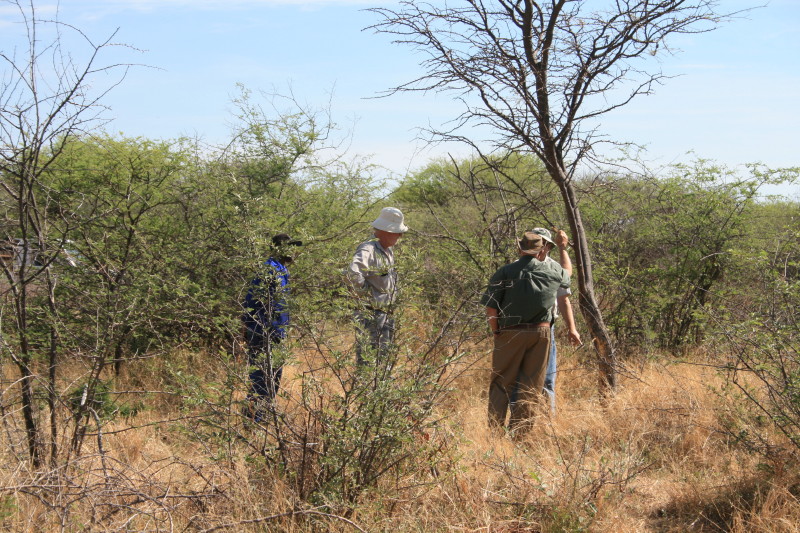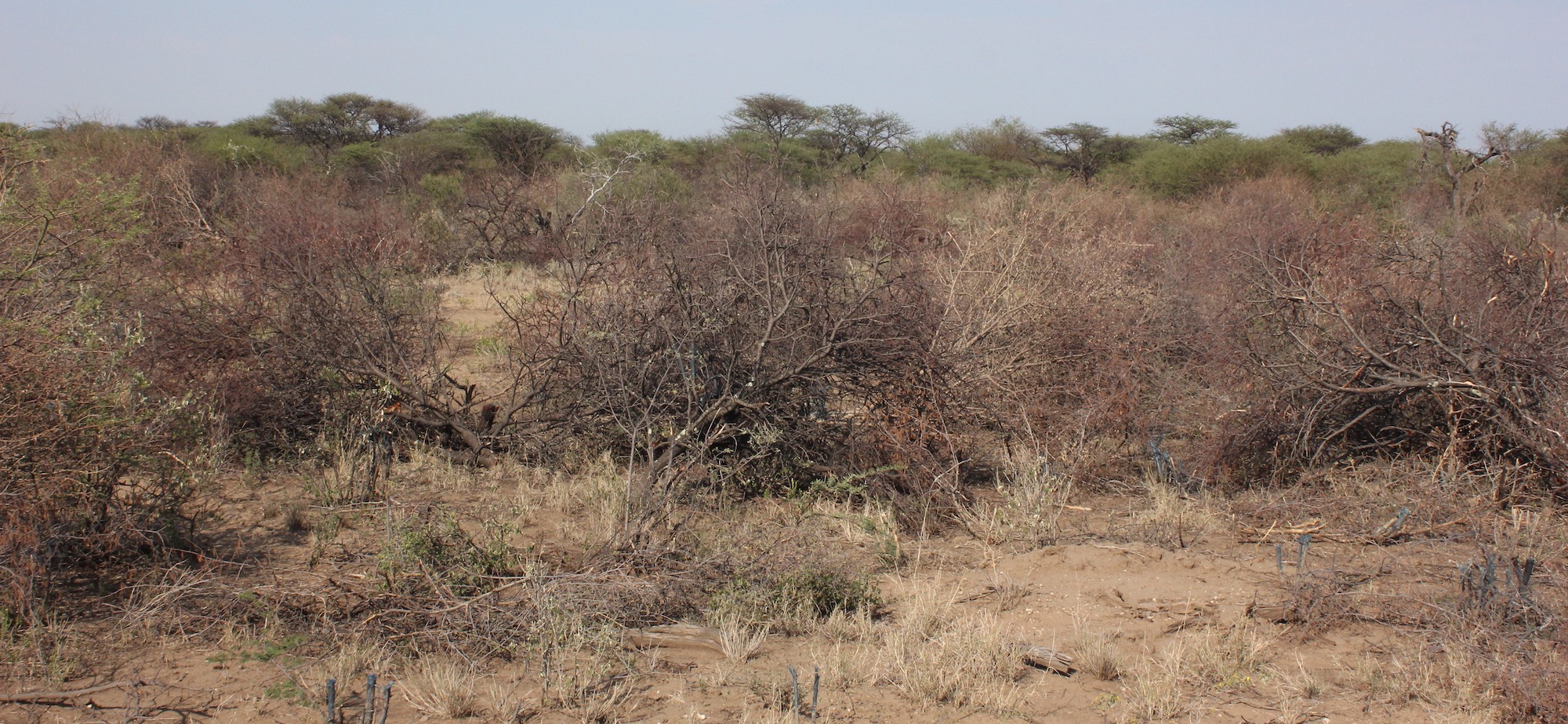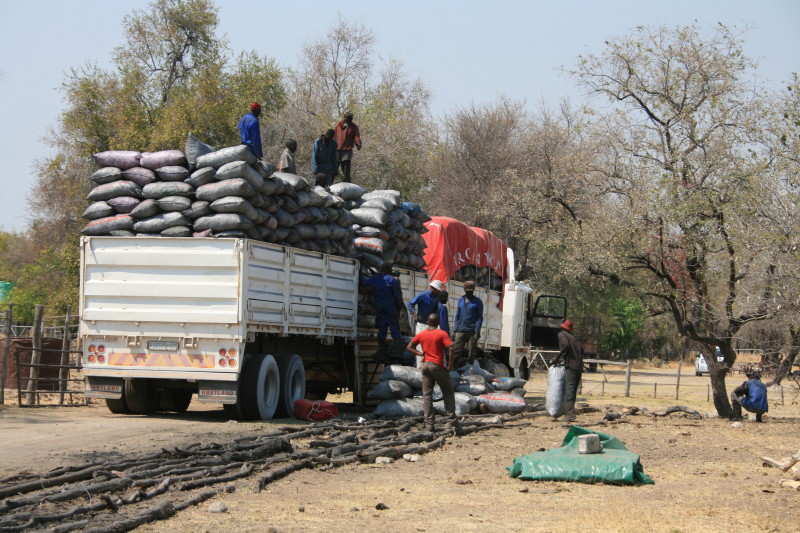
Beating Back the Bush
Recent Insights into improving Namibian Rangeland Productivity and Biodiversity
By Gail C. Potgieter
9th August 2019
If you have ever driven from Windhoek to Tsumeb or Grootfontein, via Okahandja and Otjiwarongo, you will have noticed that much of the landscape around you is dominated by bush. Visitors to Namibia driving this route will be struck by how few people and buildings they encounter. The seemingly endless tracts of farmland give the impression of wilderness. What you may not realise is that the dense bush all around you represents one of the greatest agricultural and ecological challenges facing Namibia today.
A bush, as opposed to a tree, is defined as a woody plant that rarely grows taller than 10 feet, and usually has multiple stems rather than one long trunk. The thorny bush species like Black Thorn and Sickle Bush grow so densely in places that it would be difficult to walk through some of the farms you encounter on the journey north, although non-thorny species like Mopane and Cluster-Leaf Terminalia dominate the landscape around Outjo and Gobabis, respectively. The bushes mentioned here are indigenous to Namibia, which begs the question – why is this issue, known as bush encroachment or thickening, considered a problem?

The problem is not so much the presence of these bushes, but their density. Most of the northern half of Namibia (except the desert in the far west) is classified as a savannah ecosystem. Healthy savannahs are characterised by a balance between grass and bush, with the proportions of each depending on local ecological conditions. Although not easily apparent to human observers, the grasses and woody plants in a savannah are in constant competition with each other. Solid grass cover provides fuel to feed an occasional fierce fire that kills young bushes, whereas the widespread roots of bushes and trees dry out the surrounding soil, making it difficult for grass to grow.
Whether the grass or the trees ‘win’ this competition changes over time and space, and depends on a bewildering array of factors, including: rainfall, soil nutrients, fire, grazing and browsing by herbivores, and even the amount of carbon dioxide in the atmosphere. It is therefore no surprise that scientists continue the debate about which of these factors are the main causes of the increasing dominance of bushes over grasses in Namibia and similar ecosystems elsewhere. There is even debate about how open or bushy Namibian savannahs were before colonial commercial farming systems were first established. The state of the savannah before any form of livestock farming took place (e.g. by Herero and Nama people) is entirely unknown to modern day scientists.

Commercial farmers historically replaced wild herbivores, which ate both grass and leaves, with large numbers of cattle and sheep that rely almost entirely on grass. Besides differences in diet, wild herbivores used to move over large tracts of land in response to highly patchy rainfall patterns in Namibia, but this migration was disrupted by fencing commercial farms. The result is that domestic and wild herbivores stay on the same farmlands year round, thus putting continuous pressure on the plants they eat.
Furthermore, early commercial farmers viewed fire as destructive and would therefore prevent it as far as possible, not realising that grass is rejuvenated by occasional natural fires at the start of the rainy season, usually caused by lightning striking dry grass. On a broader scale, humans have altered nutrient, water and carbon cycles through their agricultural and industrial practices. One of the results of these environmental impacts is that the competition between grass and bush has tipped the balance heavily in favour of the bush.
Densely bushed farms are economically as well as ecologically less productive than they were historically. Farmers can keep fewer cattle and sheep on land where little grass grows within dense bush thickets, resulting in low economic returns for large tracts of land. Ecologically, a healthy mix of grass and bush provides habitats for a larger variety of animal and plant species than is provided by a system dominated by one or the other. Reducing bush encroachment in Namibia is therefore important for both the economy and the environment.

The first volume of the Namibian Journal of Environment (NJE), published in 2017, contained three scientific articles concerning bush encroachment, emphasizing the importance of this topic to environmental scientists in Namibia. I will take this opportunity to touch on some aspects of their contributions to our knowledge about bush encroachment and potential solutions for Namibia.
Dave Joubert and colleagues pointed out in their article that Black Thorn grows so slowly in their study area (a farm near Windhoek) that the bush thickets seen there today were already present over 50 years ago. This is supported by Peter Cunningham’s 2014 review of notes by early European explorers in Namibia who indicate that they frequently encountered dense bush thickets in the period 1856-1925. These scientists contend that declining farm productivity since the 1950s cannot be attributed solely to bush encroachment, and that Namibia’s savannah has always consisted of some bushy areas.
Ibo Zimmermann and colleagues view increasing bush density as a symptom of farmers continually removing nutrients from the soil, because livestock sold for meat consumes these nutrients by eating plants. In a natural ecosystem the animals living on the land will return the nutrients to the soil through decomposition after their death. Bush encroachment is the result of reduced soil fertility, but clearing the bush from farmlands may exacerbate this problem.
While bush is usually turned into charcoal on farms in Namibia, the Cheetah Conservation Fund (CCF) uses it to produce a fuel briquette known as Bushblok. Zimmermann et al.’s study on the CCF bush clearing operation revealed that soil fertility was lowest in locations that had been totally cleared of bush, intermediate in areas where some bush was cleared, and highest in thickets that were not cleared. Ibo Zimmermann cautions that removing bush from farms without replacing mineral nutrients may not be the ideal solution, as this counteracts nature’s attempt to restore soil fertility through bush growth.
In contrast, Peter Cunningham and Frank Detering view bush as an opportunity for diversifying farm income by making charcoal and other products. Their study shows that the slow-growing Black Thorn takes 21-26 years to reach the ideal size to be harvested for charcoal, and that it can be sustainably harvested over time. Rather than managing farmlands solely for grazing livestock, Peter Cunningham suggests that farmers include the bush on their farm as a resource for diversifying their income. He also points out that leaves and twigs are not used for charcoal, but left on the land to decompose and release their minerals back into the soil.

Still within the 2017 volume of NJE, we find an intriguing opinion piece by Peter Andrews and colleagues about improving rangeland management practices to halt the decline in productivity on Namibian farmlands. They refer to lessons learnt from experiments on Australian rangelands to suggest new approaches for Namibian farmers. Among their recommendations is to clear bush in long strips along the natural contours of the land (rather than blocks), and then place the dead bush along these strips. This would imitate the self-reinforcing natural pattern of banded vegetation, which can still be seen in some parts of Namibia. When it rains, the decomposing bush, and grasses encouraged to grow underneath them, will reduce the rate of runoff (thus reducing soil erosion) and slowly release nutrients back into the soil. While this option may be more ecologically sound than harvesting and selling the bush, it means that farmers would not be able to recoup the costs of harvesting in the short-term. Improving soil fertility and moisture retention should, however, produce long-term economic gains by increasing farm productivity.
“Large scale bush clearing poses a significant desertification threat to Namibia’s rangeland, which I have noted while driving north of Windhoek,” cautions Ibo Zimmermann, “Whirlwinds are often evident blowing over the occasional large cleared block of land, yet die out at the edge when meeting the neighbouring bush encroached land; the rising hot air from cleared land often causes rain clouds to dissipate.”
Peter Cunningham notes, “Clearing bush in large blocks, or even long strips, does not imitate nature. I recommend that farmers thin the bush in a mosaic pattern, rather than clearing it”. He further suggests, “Farmers should adapt their farming methods to Namibia’s natural bushy savannah, and investigate farming with livestock that browse and graze – like goats, damara sheep, and Nguni cattle.”

Scientists estimate that between 17-41 million hectares of farmland in Namibia is affected by bush encroachment. The extent of the estimated area affected reveals disagreements about what defines an area as encroached
. With this article we have caught a glimpse of the complexity of this issue, and some of the scientific debate about its severity, causes and potential solutions. Consequently, a concerted effort from scientists, farmers and policymakers is required to find and implement affordable, practical solutions to improve the productivity and ecological integrity of Namibian farmlands.
For articles on similar topics, please click one of the following options:
References:
1. Andrews, P. et al. (2017) “Could Critical Australian Insights Illuminate Rangeland Management in Namibia?” Namibian Journal of Environment 1 B: 1–6.
https://www.nje.org.na/index.php/nje/article/view/volume1-andrews
2. Cunningham, P.L. and Detering, F. (2017) “Determining Age, Growth Rate and Regrowth for a Few Tree Species Causing Bush Thickening in North-Central Namibia.” Namibian Journal of Environment 1 A: 72–76.
https://www.nje.org.na/index.php/nje/article/view/volume1-cunningham
3. Joubert, D. et al. (2017) “Growth Rates and Mortality Patterns of Acacia mellifera Subsp. detinens in the Semi-Arid Highland Savanna, Namibia: Encroachment Is Not as Rapid as Previously Believed.” Namibian Journal of Environment 1 A: 1–5.
https://www.nje.org.na/index.php/nje/article/view/volume1-joubert
4. Zimmermann, I. et al. (2017) “The Influence of Two Levels of Debushing in Namibia’s Thornbush Savanna on Overall Soil Fertility, Measured through Bioassays.” Namibian Journal of Environment 1 A: 52–59.
https://www.nje.org.na/index.php/nje/article/view/volume1-zimmermann1
5. Cunningham, P.L. (2014) “Bush Thickening in Namibia – A Historical Perspective.” Namibia Scientific Society 62: 164-185.
If you enjoyed this page, then you might also like:



For more great articles from Conservation Namibia see below...
Conservation Namibia brought to you by:
We use cookies to monitor site usage and to help improve it. See our Privacy Policy for details. By continuing to use the site, you acknowledge acceptance of our policy.








